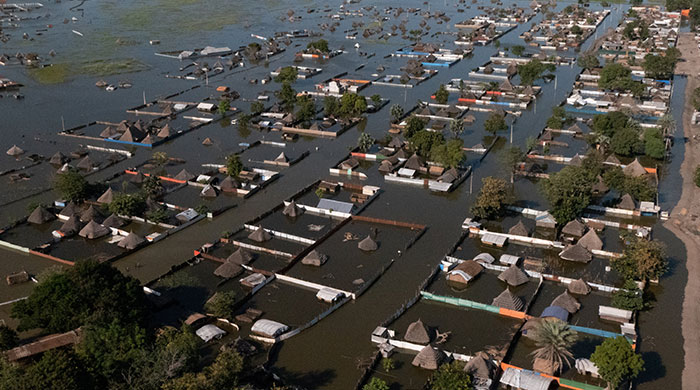Most areas the country’s large Malakal Diocese are submerged under water rising to a height of one meter (39.5 inches), says Bishop Stephen Nyodho Ador Majwok.
By Fredrick Nzwili, Catholic News Service
NAIROBI, Kenya (CNS) — Bishop Stephen Nyodho Ador Majwok of Malakal, South Sudan, called for support as floods continued to devastate his diocese, creating a complex web of challenges.
Most areas of the diocese — one of the largest in the world’s youngest nation — are submerged, with the water rising to a height of one meter (39.5 inches), the bishop said.
“The situation is really bad. It’s that of a humanitarian emergency. The whole diocese, which covers three states — Unity, Upper Nile and Jonglei — is affected,” Bishop Majwok told Catholic News Service in early December. “It’s a painful situation.”
At least 800,000 people are affected, according to the United Nations. Villages, homes, roads, farms and markets have been covered by water, forcing families to move to higher grounds where they can find safety. Some have moved to neighboring towns.
The country’s flood emergency is being linked to climate change, like in other East African nations, where unprecedented floods and storms are alternating with droughts, causing food emergencies and challenging people’s livelihoods in a region where they depend on farming and raising animals.

Floodimg partially submerged homes in Baar, South Sudan, Nov. 20, 2021. Bishop Stephen Nyodho Ador Majwok of Malakal called for support as floods continued to devastate his diocese. (CNS/Njiiri Karago/Medecins Sans Frontieres handout via Reuters)
“The humanitarian response is ongoing, but it is inadequate to meet the diverse and compounded needs of the affected people,” said a November U.N. report.
In South Sudan, the disaster has struck when the country is facing the triple challenge of conflict, hunger and the COVID-19 pandemic.
“At the moment, what is urgent is to save the people’s lives. Many are displaced and urgently need shelter, food and medicines,” said Bishop Majwok.
He explained that the previous time the region experienced similar flooding was in 1964, but it did not reach this level. Aid agencies were providing some relief, he said, but the flooding was overwhelming their capacity to help.
“A lot of work needs to be done. All roads have been closed by the floods. It means the only way to reach the area is by air. The airstrip is also threatened,” said the bishop.

Partially submerged homes are pictured amid floodwaters in Baar, South Sudan, Nov. 20, 2021. (CNS photo/Njiiri Karago/Medecins Sans Frontieres handout via Reuters)
In October, the Vatican sent $75,000 as an emergency response to the diocese. The Dicastery for Promoting Integral Human Development said the support was intended to express Pope Francis’ closeness to the people.
South Sudan, a region with many Christians and followers of African traditional religions, gained independence from the mainly Islamic and Arab north in 2011. Two years later, a civil war began, forcing thousands to leave the country as refugees and leaving millions displaced within South Sudan.
A peace agreement signed last year ended the war. However, deadly waves of intercommunal violence still continue to ignite around the competition for grazing land.
But in a new twist, the bishop says the floods have brought a bit of peace in the region.
“I can say there is some calmness now except in a few pockets,” said the bishop. “There is an area where communities were fighting, but were forced to move to a higher ground by the floods. They had no choice but to live together. This is a reality.”
Featured image: South Sudanese men navigate a canoe through floodwaters in Bentiu Nov. 20, 2021. Bishop Stephen Nyodho Ador Majwok of Malakal called for support as floods continued to devastate his diocese. (CNS photo/Njiiri Karago/Medecins Sans Frontieres handout via Reuters)

